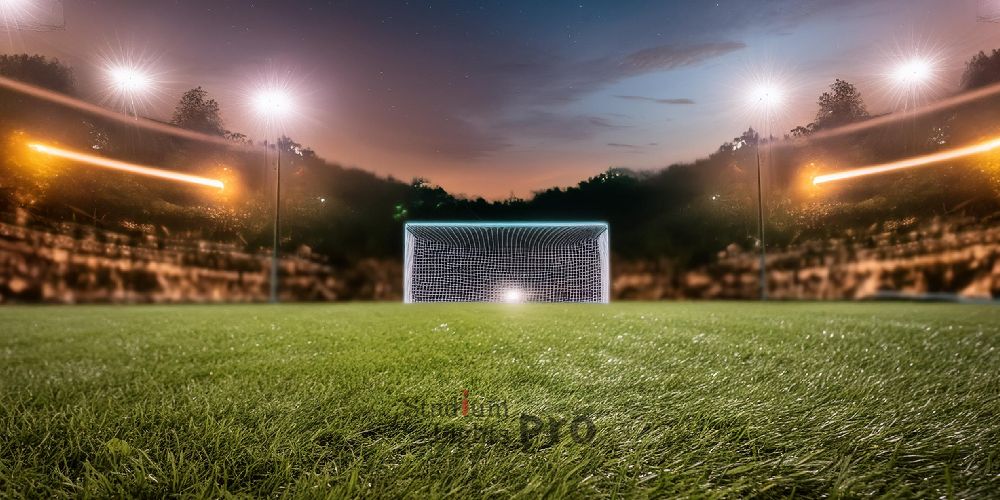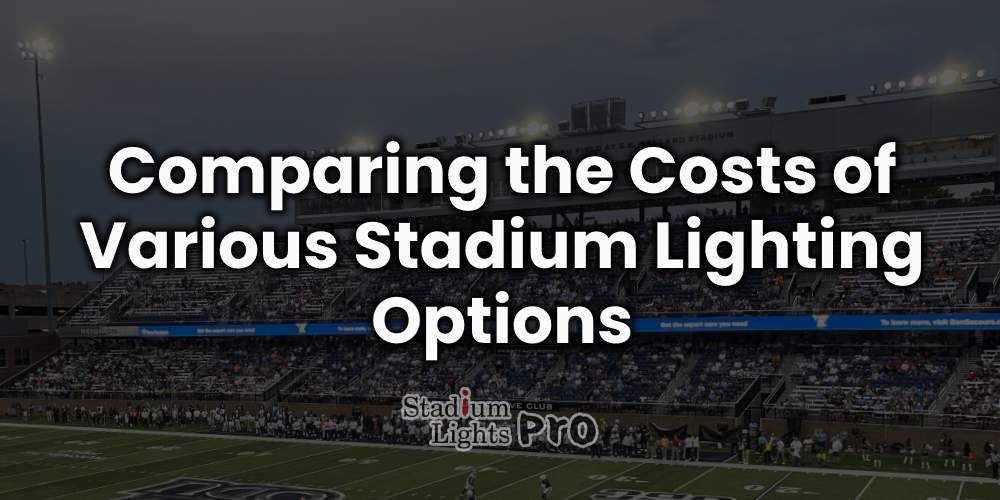Not only does it illuminate the playing field or stage for optimal visibility, but it also enhances the overall spectator experience, contributing to the atmosphere and excitement of the event. However, selecting the appropriate lighting system for a stadium involves careful consideration of various factors, including cost. The purpose of this comparison is to evaluate the costs associated with different stadium lighting options, taking into account factors such as installation expenses, operational costs, and long-term sustainability, to assist stakeholders in making informed decisions regarding their lighting investments.
Table of Contents
ToggleCost of Traditional Metal Halide Lighting
It involves fixtures that use metal halide bulbs for illumination. The initial installation cost includes expenses for equipment such as fixtures, poles, and mounting hardware, along with labor costs for installation and wiring infrastructure modifications. Maintenance requirements include quarterly cleaning and inspection, periodic bulb replacements every 2-3 years, and occasional repairs. Long-term expenses encompass ongoing energy costs for electricity consumption and replacement/maintenance costs over a 10-year period.
| Category | Traditional Metal Halide Lighting |
|---|---|
| Cost Breakdown | |
| Equipment Cost | $87,500 |
| Labor Cost | $17,500 |
| Wiring and Infrastructure | $13,200 |
| Total Initial Installation Cost | $118,200 |
| Maintenance Requirements | |
| Cleaning and Inspection | Quarterly; $44,00 annually |
| Bulb Replacements | Every 2-3 years; $1,200 per cycle |
| Repairs and Servicing | Occasional; $4,400 per year |
| Long-term Expenses | |
| Ongoing Energy Costs | $40,000 annually |
| Replacement and Maintenance | $40,000 to $80,000 over 10 years |
These figures represent estimates and may vary based on specific stadium requirements and market conditions.
Factors Contributing to Overall Price

Initial Installation Costs
When considering stadium lighting options, initial installation costs represent a significant upfront investment. The equipment cost encompasses the purchase of lighting fixtures, control systems, and any necessary accessories. This expense varies depending on the type and quality of the lighting technology chosen. Labor cost is another crucial factor, covering the wages of skilled technicians and electricians required to install the lighting system safely and efficiently. Additionally, wiring and infrastructure expenses must be factored in, including the cost of wiring materials, poles, mounting hardware, and any necessary modifications to the stadium’s electrical system to support the new lighting.
Operational Costs
Operational costs are ongoing expenses incurred during the regular use of the stadium lighting. Energy consumption is a primary operational cost, particularly for traditional lighting systems like metal halide, which can be energy-intensive compared to newer, more energy-efficient alternatives such as LED or solar-powered lighting. Maintenance and servicing expenses include routine tasks such as cleaning, inspection, and minor repairs to ensure the lighting system remains functional and compliant with safety regulations. Replacement parts and bulbs are also recurring costs, as bulbs eventually degrade and require replacement, and other components may need repair or upgrading over time.
Long-Term Costs
Long-term costs encompass factors that affect the overall lifespan and performance of the stadium lighting system. The lifespan of the lighting system itself influences long-term costs, as longer-lasting systems require fewer replacements and repairs, reducing maintenance expenses. Upgradability and scalability refer to the flexibility of the lighting system to accommodate future changes or expansions in the stadium’s lighting needs, which can affect long-term costs if upgrades or modifications are necessary. Lastly, considering the potential for future technological advancements is crucial, as investing in a lighting system with room for technological growth can help mitigate the risk of obsolescence and future-proof the stadium’s lighting infrastructure.
Comparison of Different Stadium Lighting Options

Traditional Metal Halide Lighting
Initial installation costs
Traditional metal halide lighting systems typically have moderate to high initial installation costs. This includes expenses related to purchasing the lighting fixtures, mounting hardware, and associated wiring and infrastructure. Additionally, labor costs for skilled technicians and electricians contribute significantly to the overall installation expenses.
Operational costs
Operational costs for traditional metal halide lighting systems primarily consist of energy consumption. Metal halide bulbs are known for their relatively high energy usage compared to more energy-efficient alternatives like LED lighting. Consequently, stadiums with metal halide lighting may face higher electricity bills over time, particularly during extended use for evening events.
Long-term costs
Long-term costs associated with traditional metal halide lighting systems include maintenance and servicing expenses. These systems require regular maintenance to ensure optimal performance and safety, including bulb replacements, cleaning, and occasional repairs. Additionally, the lifespan of metal halide bulbs is shorter compared to LED or solar-powered alternatives, leading to more frequent replacement costs and potentially higher long-term expenses.
LED Lighting
Initial installation costs
LED lighting systems typically have higher initial installation costs compared to traditional lighting options due to the expense of LED fixtures, control systems, and any necessary infrastructure upgrades. However, the gap in installation costs has been narrowing as LED technology becomes more widespread and cost-effective. Initial expenses include purchasing LED fixtures, control systems, and any necessary infrastructure modifications to support the new lighting. Despite the higher upfront investment, the long-term benefits of LED lighting, including energy savings and reduced maintenance costs, often justify the initial expense.
Operational costs
LED lighting is renowned for its energy efficiency, resulting in lower operational costs compared to traditional lighting options. LED bulbs consume significantly less electricity while providing comparable or better illumination, leading to substantial savings on energy bills over the lifetime of the system. Additionally, LED fixtures have a longer lifespan compared to traditional bulbs, reducing the frequency of replacements and associated maintenance costs. The combination of lower energy consumption and reduced maintenance requirements makes LED lighting a cost-effective choice for stadiums and other large-scale lighting applications.
Long-term costs
Long-term costs for LED lighting systems are generally lower compared to traditional lighting options. LED bulbs have a much longer lifespan than traditional bulbs, lasting up to 25 times longer on average. This extended lifespan reduces the frequency of replacements, lowering maintenance expenses over time. Additionally, LED fixtures require less maintenance compared to traditional lighting options, further reducing long-term costs. While the initial investment in LED lighting may be higher, the significant energy savings and reduced maintenance expenses over the lifespan of the system result in substantial long-term cost savings. Overall, LED lighting offers a compelling combination of energy efficiency, durability, and cost-effectiveness for stadium and arena lighting applications.
Solar-Powered Lighting
Initial installation costs
Solar-powered lighting systems typically entail higher initial installation costs compared to traditional grid-powered or LED lighting systems due to the investment in solar panels, battery storage systems, and other necessary components to harness and store solar energy. The cost of solar panels and batteries, along with installation labor and any required infrastructure modifications, contribute to the upfront investment. Factors such as the size of the solar array, battery capacity, and site-specific considerations also influence the initial installation costs of solar-powered lighting systems. Despite the higher upfront investment, solar-powered lighting offers long-term cost savings and environmental benefits through reduced reliance on grid electricity and lower operational expenses.
Operational costs
One of the primary advantages of solar-powered lighting is its minimal operational costs once the system is installed. Solar energy is abundant, renewable, and free, resulting in significant savings on electricity bills compared to grid-powered lighting systems. Operational costs for solar-powered lighting systems primarily include periodic maintenance and servicing to ensure optimal performance and longevity. This may involve tasks such as cleaning solar panels, inspecting battery health, and performing routine maintenance on lighting fixtures and control systems. However, the operational expenses of solar-powered lighting are generally lower compared to grid-powered alternatives over the lifespan of the system, making it a cost-effective and sustainable lighting solution for stadiums and outdoor venues.
Long-term costs
Solar-powered lighting systems offer compelling long-term cost benefits, including reduced energy expenses, minimal ongoing maintenance requirements, and long-term reliability. Once the initial installation costs are recouped, solar-powered lighting systems benefit from virtually free and renewable solar energy, resulting in significant long-term cost savings compared to grid-powered alternatives. The lifespan of solar panels and batteries used in solar-powered lighting systems is typically several decades, reducing the need for frequent replacements and associated long-term expenses. Additionally, solar-powered lighting systems contribute to environmental sustainability by reducing carbon emissions and reliance on finite fossil fuels, further enhancing their long-term value proposition. Overall, solar-powered lighting represents a cost-effective, environmentally friendly, and sustainable lighting solution for stadiums and outdoor venues, offering both economic and environmental benefits over the long term.
Hybrid Lighting Systems
Initial installation costs
Hybrid lighting systems, which integrate elements of multiple lighting technologies such as solar, LED, and traditional grid-powered sources, can have variable initial installation costs depending on the specific configuration and components chosen. These systems typically involve the installation of solar panels, battery storage systems, LED fixtures, and potentially grid connections to provide backup power or supplement renewable energy generation. The complexity and customization of hybrid systems can impact the upfront investment required. Factors such as the size of the solar array, battery capacity, and the proportion of renewable energy sources utilized contribute to the initial installation costs. Additionally, labor costs for system design, integration, and installation also influence the overall upfront investment in hybrid lighting systems.
Operational costs
Operational costs for hybrid lighting systems vary depending on the proportion of renewable energy sources utilized and the efficiency of the system’s components. Hybrid systems offer the potential for energy savings compared to purely grid-powered setups, particularly when incorporating solar or wind energy generation. However, operational expenses may include maintenance and servicing of solar panels, batteries, LED fixtures, and other system components to ensure reliable performance. Additionally, factors such as weather conditions and energy consumption patterns can influence operational costs and system efficiency. The operational costs of hybrid lighting systems may be higher compared to standalone solar or LED lighting systems due to the complexity and maintenance requirements of integrating multiple technologies.
Long-term costs
Long-term costs for hybrid lighting systems depend on factors such as the durability and reliability of the integrated components, the effectiveness of renewable energy sources, and ongoing maintenance requirements. Hybrid systems offer the potential for long-term energy savings and reduced environmental impact by utilizing renewable energy sources. However, the complexity of hybrid systems may result in higher long-term maintenance and servicing costs compared to simpler lighting setups. Additionally, the adaptability and scalability of hybrid systems can impact their long-term viability and cost-effectiveness, as technological advancements and changing energy needs may require system upgrades or modifications over time. Despite potentially higher initial and operational costs, hybrid lighting systems offer the benefits of increased energy resilience, reduced environmental impact, and flexibility in meeting diverse lighting needs, making them a compelling option for stadiums and outdoor venues seeking sustainable lighting solutions.
Conclusion
The case studies of traditional metal halide lighting, LED lighting, and solar-powered lighting systems illustrate the diverse costs and considerations associated with stadium lighting. While traditional metal halide lighting may offer adequate illumination, its high initial installation costs, ongoing maintenance requirements, and energy consumption present significant long-term expenses. LED lighting emerges as a cost-effective alternative, with lower operational costs, longer lifespan, and higher energy efficiency, making it an attractive option for stadiums seeking to minimize expenses while enhancing sustainability. Solar-powered lighting systems demonstrate the potential for renewable energy integration, offering long-term savings and environmental benefits despite higher initial investment costs. As stadiums continue to prioritize cost-effectiveness and sustainability, future considerations should include ongoing advancements in lighting technologies, such as improved efficiency, smart lighting controls, and innovative renewable energy solutions, to further optimize performance and reduce environmental impact.

